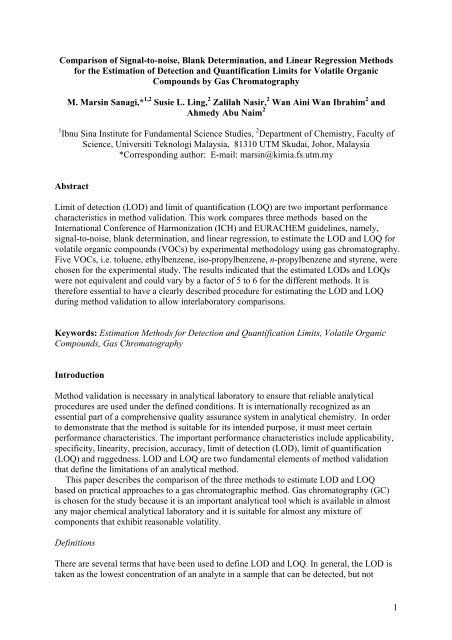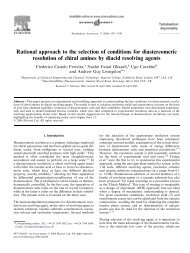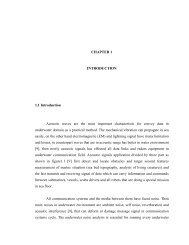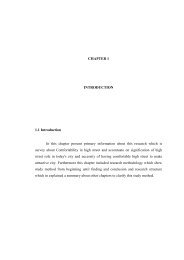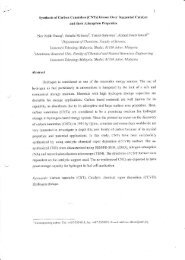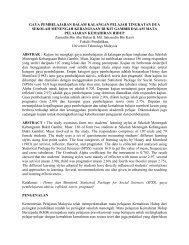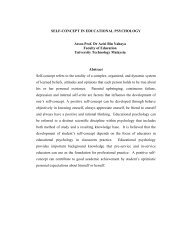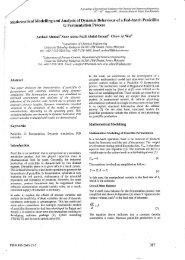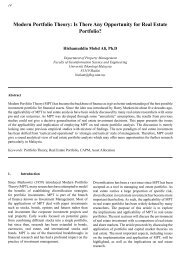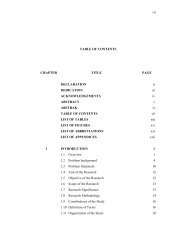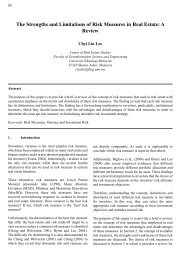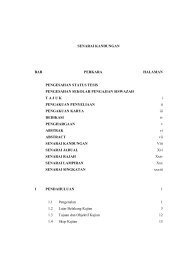Comparison of Signal-to-noise, Blank Determination, and - Universiti ...
Comparison of Signal-to-noise, Blank Determination, and - Universiti ...
Comparison of Signal-to-noise, Blank Determination, and - Universiti ...
Create successful ePaper yourself
Turn your PDF publications into a flip-book with our unique Google optimized e-Paper software.
<strong>Comparison</strong> <strong>of</strong> <strong>Signal</strong>-<strong>to</strong>-<strong>noise</strong>, <strong>Blank</strong> <strong>Determination</strong>, <strong>and</strong> Linear Regression Methods<br />
for the Estimation <strong>of</strong> Detection <strong>and</strong> Quantification Limits for Volatile Organic<br />
Compounds by Gas Chroma<strong>to</strong>graphy<br />
M. Marsin Sanagi,* 1,2 Susie L. Ling, 2 Zalilah Nasir, 2 Wan Aini Wan Ibrahim 2 <strong>and</strong><br />
Ahmedy Abu Naim 2<br />
1 Ibnu Sina Institute for Fundamental Science Studies, 2 Department <strong>of</strong> Chemistry, Faculty <strong>of</strong><br />
Science, <strong>Universiti</strong> Teknologi Malaysia, 81310 UTM Skudai, Johor, Malaysia<br />
*Corresponding author: E-mail: marsin@kimia.fs.utm.my<br />
Abstract<br />
Limit <strong>of</strong> detection (LOD) <strong>and</strong> limit <strong>of</strong> quantification (LOQ) are two important performance<br />
characteristics in method validation. This work compares three methods based on the<br />
International Conference <strong>of</strong> Harmonization (ICH) <strong>and</strong> EURACHEM guidelines, namely,<br />
signal-<strong>to</strong>-<strong>noise</strong>, blank determination, <strong>and</strong> linear regression, <strong>to</strong> estimate the LOD <strong>and</strong> LOQ for<br />
volatile organic compounds (VOCs) by experimental methodology using gas chroma<strong>to</strong>graphy.<br />
Five VOCs, i.e. <strong>to</strong>luene, ethylbenzene, iso-propylbenzene, n-propylbenzene <strong>and</strong> styrene, were<br />
chosen for the experimental study. The results indicated that the estimated LODs <strong>and</strong> LOQs<br />
were not equivalent <strong>and</strong> could vary by a fac<strong>to</strong>r <strong>of</strong> 5 <strong>to</strong> 6 for the different methods. It is<br />
therefore essential <strong>to</strong> have a clearly described procedure for estimating the LOD <strong>and</strong> LOQ<br />
during method validation <strong>to</strong> allow interlabora<strong>to</strong>ry comparisons.<br />
Keywords: Estimation Methods for Detection <strong>and</strong> Quantification Limits, Volatile Organic<br />
Compounds, Gas Chroma<strong>to</strong>graphy<br />
Introduction<br />
Method validation is necessary in analytical labora<strong>to</strong>ry <strong>to</strong> ensure that reliable analytical<br />
procedures are used under the defined conditions. It is internationally recognized as an<br />
essential part <strong>of</strong> a comprehensive quality assurance system in analytical chemistry. In order<br />
<strong>to</strong> demonstrate that the method is suitable for its intended purpose, it must meet certain<br />
performance characteristics. The important performance characteristics include applicability,<br />
specificity, linearity, precision, accuracy, limit <strong>of</strong> detection (LOD), limit <strong>of</strong> quantification<br />
(LOQ) <strong>and</strong> ruggedness. LOD <strong>and</strong> LOQ are two fundamental elements <strong>of</strong> method validation<br />
that define the limitations <strong>of</strong> an analytical method.<br />
This paper describes the comparison <strong>of</strong> the three methods <strong>to</strong> estimate LOD <strong>and</strong> LOQ<br />
based on practical approaches <strong>to</strong> a gas chroma<strong>to</strong>graphic method. Gas chroma<strong>to</strong>graphy (GC)<br />
is chosen for the study because it is an important analytical <strong>to</strong>ol which is available in almost<br />
any major chemical analytical labora<strong>to</strong>ry <strong>and</strong> it is suitable for almost any mixture <strong>of</strong><br />
components that exhibit reasonable volatility.<br />
Definitions<br />
There are several terms that have been used <strong>to</strong> define LOD <strong>and</strong> LOQ. In general, the LOD is<br />
taken as the lowest concentration <strong>of</strong> an analyte in a sample that can be detected, but not<br />
1
necessarily quantified, under the stated conditions <strong>of</strong> the test. The LOQ is the lowest<br />
concentration <strong>of</strong> an analyte in a sample that can be determined with acceptable precision <strong>and</strong><br />
accuracy under the stated conditions <strong>of</strong> test (1).<br />
The IUPAC definition states that “the limit <strong>of</strong> detection, expressed as the concentration, cL<br />
,<br />
or the quantity, qL , is derived from the smallest measure, L that can be detected with<br />
reasonable certainty for a given analytical procedure. The value <strong>of</strong><br />
x<br />
x L is given by the<br />
following equation:<br />
x = x + ks<br />
L<br />
bi<br />
where i b x is the mean <strong>of</strong> the blank measures, sb<br />
is the st<strong>and</strong>ard deviation <strong>of</strong> the blank<br />
i<br />
measures, <strong>and</strong> k is a numerical fac<strong>to</strong>r chosen according <strong>to</strong> the confidence level desired (2).”<br />
Furthermore, Long <strong>and</strong> Winefordner (3) has suggested converting measurement units, xL<br />
<strong>to</strong><br />
concentration, cL<br />
as follows:<br />
( xL<br />
+ xb<br />
) i<br />
cL<br />
=<br />
m<br />
where m is the analytical sensitivity. By substituting equation xL in<strong>to</strong> equation L , this<br />
becomes:<br />
c<br />
ksbi<br />
cL<br />
=<br />
m<br />
The value <strong>of</strong> k equals <strong>to</strong> three has been recommended by IUPAC (4) <strong>and</strong> other authors (3,5,6)<br />
which allows a confidence level <strong>of</strong> 99.87% for the values <strong>of</strong> x following a normal<br />
distribution.<br />
Methods <strong>of</strong> estimating LOD <strong>and</strong> LOQ<br />
There are several possible conceptual methods regarding LOD <strong>and</strong> LOQ, each providing a<br />
somewhat different definition. Depending on the definition chosen, the values <strong>of</strong> LOD <strong>and</strong><br />
LOQ can vary greatly which make it difficult for comparative purposes. In this paper, the<br />
three methods based on International Conference <strong>of</strong> Harmonization (ICH) (6) <strong>and</strong><br />
EURACHEM (7) guidelines are discussed.<br />
<strong>Signal</strong>- <strong>to</strong>-<strong>noise</strong><br />
By using the signal-<strong>to</strong>-<strong>noise</strong> method (6), the peak-<strong>to</strong>-peak <strong>noise</strong> around the analyte retention<br />
time is measured, <strong>and</strong> subsequently, the concentration <strong>of</strong> the analyte that would yield a signal<br />
equal <strong>to</strong> certain value <strong>of</strong> <strong>noise</strong> <strong>to</strong> signal ratio is estimated. The <strong>noise</strong> magnitude can be<br />
measured either manually on the chroma<strong>to</strong>gram prin<strong>to</strong>ut or by au<strong>to</strong>-integra<strong>to</strong>r <strong>of</strong> the<br />
instrument. A signal-<strong>to</strong>-<strong>noise</strong> ratio (S/N) <strong>of</strong> three is generally accepted for estimating LOD<br />
<strong>and</strong> signal-<strong>to</strong>-<strong>noise</strong> ratio <strong>of</strong> ten is used for estimating LOQ. This method is commonly applied<br />
<strong>to</strong> analytical methods that exhibit baseline <strong>noise</strong>.<br />
<strong>Blank</strong> determination<br />
The blank determination (7) is applied when the blank analysis gives results with a non-zero<br />
st<strong>and</strong>ard deviation. LOD is expressed as the analyte concentration corresponding <strong>to</strong> the<br />
sample blank value plus three st<strong>and</strong>ard deviation <strong>and</strong> LOQ is the analyte concentration<br />
corresponding <strong>to</strong> the sample blank value plus ten st<strong>and</strong>ard deviations as shown in the<br />
following equations:<br />
bi<br />
bi<br />
2
LOD ≅ x + 3s<br />
bi<br />
bi<br />
bi<br />
LOQ ≅ x + 10s<br />
where i b x is the mean concentration <strong>of</strong> the blank <strong>and</strong> sb<br />
is the st<strong>and</strong>ard deviation <strong>of</strong> the blank.<br />
i<br />
Linear regression<br />
For a linear calibration curve, it is assumed that the instrument response y is linearly related<br />
<strong>to</strong> the st<strong>and</strong>ard concentration x for a limited range <strong>of</strong> concentration. It can be expressed in a<br />
model such as:<br />
y = a + bx<br />
This model is used <strong>to</strong> compute the sensitivity b <strong>and</strong> the LOD <strong>and</strong> LOQ (6). Therefore the<br />
LOD <strong>and</strong> LOQ can be expressed as:<br />
3s<br />
LOD ≅<br />
b<br />
a<br />
10s<br />
LOQ ≅<br />
b<br />
where s a is the st<strong>and</strong>ard deviation <strong>of</strong> the response <strong>and</strong> b is the slope <strong>of</strong> the calibration curve.<br />
The st<strong>and</strong>ard deviation <strong>of</strong> the response s can be estimated by the st<strong>and</strong>ard deviation <strong>of</strong><br />
a<br />
either y-residuals, s or y-intercepts, s <strong>of</strong> regression lines. This method can be applied in<br />
res<br />
y0<br />
all cases, <strong>and</strong> it is most applicable when the analysis method does not involve background<br />
<strong>noise</strong>. It uses a range <strong>of</strong> low values close <strong>to</strong> zero for calibration curve, <strong>and</strong> with a more<br />
homogeneous distribution will result in a more relevant assessment.<br />
Experimental<br />
St<strong>and</strong>ards <strong>and</strong> reagents<br />
The reference st<strong>and</strong>ards for <strong>to</strong>luene, ethylbenzene, iso-propylbenzene, n-propylbenzene <strong>and</strong><br />
styrene with a purity higher than 98% were supplied by Kan<strong>to</strong> (Tokyo, Japan).<br />
Dichloromethane (DCM) (Ultra-resi-analyzed grade) was obtained from J.T. Baker (USA). A<br />
s<strong>to</strong>ck solution <strong>of</strong> 1000 µg/mL in DCM was prepared separately for the five test compounds.<br />
A mixture solution at a level <strong>of</strong> 10 µg/mL was prepared from the s<strong>to</strong>ck solution above using<br />
the same solvent. A series <strong>of</strong> working st<strong>and</strong>ard solutions ranging from 0.2 µg/mL <strong>to</strong> 4.0<br />
µg/mL were prepared from the mixture solution (10 µg/mL) by dilution in DCM.<br />
Instrument <strong>and</strong> chroma<strong>to</strong>graphic conditions<br />
A Shidmazu (Kyo<strong>to</strong>, Japan) Model 17A gas chroma<strong>to</strong>graph equipped with flame-ionization<br />
detec<strong>to</strong>r (FID) <strong>and</strong> a Shimadzu AOC-20i au<strong>to</strong>sampler was used. A CP-WAX 52CB WCOT<br />
a<br />
bi<br />
3
fused-silica capillary column (30 m × 0.25 mm I.D., Varian) with 0.25 µm film thickness was<br />
used with helium as carrier gas at a rate <strong>of</strong> 8 ml/min. The initial oven temperature was held<br />
isothermically at 50°C for 5 min, increased <strong>to</strong> 110°C at 4°C min -1 , then raised <strong>to</strong> 230°C at<br />
20°C min -1 <strong>and</strong> maintained at 230°C for 4 min. The injec<strong>to</strong>r was set at split mode (1:10),<br />
injec<strong>to</strong>r temperature was held constant at 220°C, <strong>and</strong> injection volume <strong>of</strong> 1.0 µL. The FID<br />
temperature was kept at 240°C. The chroma<strong>to</strong>graphic data were analyzed <strong>and</strong> processed<br />
using a Shimadzu Class-VP 4.3 acquisition program.<br />
Procedure<br />
For the purpose <strong>of</strong> comparison between different approaches, DCM was used as a blank<br />
sample. The levels <strong>of</strong> concentration for each compound <strong>and</strong> number <strong>of</strong> replicates <strong>and</strong><br />
measurements performed by using the three methods are listed in Table 1.<br />
In order <strong>to</strong> respect measurement independence, each replicate was performed on a newly<br />
prepared st<strong>and</strong>ard solution <strong>and</strong> the replicates were carried out on different days <strong>to</strong> take in<strong>to</strong><br />
consideration <strong>of</strong> run effect. The run effects accounts for day-<strong>to</strong>-day variations in the<br />
analytical system, such as batches <strong>of</strong> reagents, recalibration <strong>of</strong> instruments, <strong>and</strong> the labora<strong>to</strong>ry<br />
environment changes.<br />
For generation <strong>of</strong> calibration curve, the concentration levels were chosen in a range around<br />
LOD <strong>and</strong> LOQ <strong>to</strong> ensure the homoscedasticity, the independence <strong>of</strong> the area dispersion in<br />
relation <strong>to</strong> analyte quantity.<br />
Data Analysis<br />
Micros<strong>of</strong>t <strong>of</strong>fice excels (2003) spreadsheet was chosen <strong>to</strong> s<strong>to</strong>re, display raw data <strong>and</strong> <strong>to</strong><br />
perform statistical calculations with the built-in statistical functions.<br />
Results <strong>and</strong> discussion<br />
Under the instrumental operating conditions as described above, the VOCs were perfectly<br />
separated as shown in Figure 1. The elution order for the five compounds is <strong>to</strong>luene [1],<br />
ethylbenzene [2], iso-propylbenzene [3], n-propylbenzene [4] <strong>and</strong> styrene [5].<br />
<strong>Signal</strong>- <strong>to</strong>- <strong>noise</strong><br />
The <strong>noise</strong> value was calculated based on the peak height <strong>of</strong> the blank (DCM) around the<br />
retention time <strong>of</strong> each analyte using au<strong>to</strong>-integra<strong>to</strong>r. LOD was estimated as three times <strong>noise</strong><br />
value <strong>and</strong> LOQ was estimated as ten times <strong>noise</strong> value as shown in Table 2.<br />
This method is widely used for instrument method such as gas chroma<strong>to</strong>graphy as it is<br />
easy <strong>to</strong> implement. However, the stability <strong>of</strong> the instrument response on day-<strong>to</strong>-day basis will<br />
affect the results obtained. In this study, 10 independent numbers <strong>of</strong> blank <strong>to</strong>gether with the<br />
st<strong>and</strong>ard solution at the level <strong>of</strong> 0.4 µg/mL were analyzed separately on different days. Due <strong>to</strong><br />
the run effect <strong>of</strong> the instrument, the relative st<strong>and</strong>ard deviations for the 10 measurements<br />
ranged from 25% <strong>to</strong> 44% for the five test compounds. This method depends heavily on<br />
individual analyst’s interpretation <strong>of</strong> how <strong>to</strong> obtain the magnitude <strong>of</strong> <strong>noise</strong> whether by<br />
manual measurement or using au<strong>to</strong>-integra<strong>to</strong>r <strong>of</strong> the instrument. Therefore the values<br />
obtained are difficult for comparison between different analysts or labora<strong>to</strong>ries.<br />
<strong>Blank</strong> determination<br />
4
<strong>Blank</strong> determination was carried out by analysis <strong>of</strong> 10 independent sample blanks, the mean<br />
concentration <strong>and</strong> the st<strong>and</strong>ard deviations <strong>of</strong> the blank results were calculated (Table 3).<br />
The blank determination method as described in EURACHEM guide (7) , LOD is<br />
estimated as 3s more than the blank value as it assumes that a signal more than 3 times above<br />
the st<strong>and</strong>ard deviation <strong>of</strong> the sample blank value is likely <strong>to</strong> have arisen from the measur<strong>and</strong>.<br />
For this approach, it needs a sample blank for each sample matrix <strong>to</strong> be analyzed, <strong>and</strong> the<br />
estimated LOD <strong>and</strong> LOQ may vary for different sample matrices. However, getting a true<br />
sample blank can be difficult <strong>and</strong> in certain situation, reagent blank is used as a blank. The<br />
LOD <strong>and</strong> LOQ estimated by using reagent blank does not take in<strong>to</strong> consideration <strong>of</strong> matrix<br />
interference, <strong>and</strong> the estimated values can be smaller than that using true sample blank.<br />
Linear Regression<br />
Linear ordinary least-squares regression parameters were calculated based on the analysis <strong>of</strong><br />
ten replicates <strong>of</strong> test compounds at seven different concentration levels. The data obtained<br />
were used <strong>to</strong> compute the two coefficient <strong>of</strong> the calibration curve <strong>and</strong> also <strong>to</strong> perform a lack<strong>of</strong>-fit<br />
test, which was used <strong>to</strong> verify that the selected calibration domain was actually linear.<br />
The st<strong>and</strong>ard deviation <strong>of</strong> the blank was estimated by using both st<strong>and</strong>ard deviation <strong>of</strong><br />
regression residual ( ) <strong>and</strong> y – intercept ( s ) as shown in Table 4 <strong>and</strong> results <strong>of</strong> the<br />
sres 0 y<br />
statistical evaluation <strong>of</strong> the linear regression curve is shown in Table 5.<br />
The calculation <strong>of</strong> the test table showed that the test for regression was significant while<br />
the F observed value for each analyte was much higher than the critical value <strong>of</strong> 3.993, which<br />
corresponded <strong>to</strong> F(1,69,5%). This meant that the instrumental response was significantly<br />
correlated <strong>to</strong> the analyte concentration. When the lack-<strong>of</strong>-fit test was performed, the Fisher<br />
variable associated <strong>to</strong> the test for the error <strong>of</strong> model was smaller than the critical value <strong>of</strong><br />
2.361. It can be concluded that the error <strong>of</strong> model was not significant at the risk level <strong>of</strong> 5%<br />
<strong>and</strong> the proposed linearity domain could be accepted.<br />
The linear regression method can help <strong>to</strong> solve the problem <strong>of</strong> difficulty in obtaining<br />
matrix blank for other methods. This is because calibration curve can be prepared by sample<br />
addition method. From this study, the results showed that the y-intercept st<strong>and</strong>ard deviation<br />
<strong>and</strong> y-residual st<strong>and</strong>ard deviation varied greatly. The values <strong>of</strong> y-intercept st<strong>and</strong>ard deviation<br />
were much lower than those <strong>of</strong> y-residual st<strong>and</strong>ard deviation for the five analytes. These<br />
results were in agreement with the study reported by Vial <strong>and</strong> Jardy (8). The values <strong>of</strong> LOD<br />
<strong>and</strong> LOQ obtained by this method can vary depending on the number <strong>of</strong> concentration levels,<br />
range <strong>of</strong> concentration used, number <strong>of</strong> measurement <strong>and</strong> data heteroscedasticity. The<br />
ordinary least-square regression is used in this case with the assumption that the data obtained<br />
are homoscedastic, if not; the weighted least-square regression is preferred.<br />
<strong>Comparison</strong> <strong>of</strong> LOD <strong>and</strong> LOQ by different methods<br />
Based on the experimental results, the LOD <strong>and</strong> LOQ were estimated for the different<br />
methods as summarized in Table 6 <strong>and</strong> Table 7.<br />
For LOD, the values obtained by signal-<strong>to</strong>-<strong>noise</strong> <strong>and</strong> blank determination methods were<br />
close <strong>to</strong> each other. The linear regression method by using s showed largest values <strong>of</strong> LOD<br />
<strong>and</strong> by using s gave lowest values <strong>of</strong> LOD for all the analytes. For LOQ, similar trend<br />
y<br />
0<br />
observed for linear regression method as in LOD. However, the signal-<strong>to</strong>-<strong>noise</strong> method<br />
presented about two times values <strong>of</strong> LOQ as compared <strong>to</strong> blank determination method. The<br />
LOQ values obtained by blank determination were comparable <strong>to</strong> linear regression method<br />
res<br />
5
using s . From these findings, it seemed that not all the methods used <strong>to</strong> estimate LOD <strong>and</strong><br />
y<br />
0<br />
LOQ in this study were equivalent. The differences between the smallest <strong>and</strong> the largest<br />
values estimated by different methods could vary by a fac<strong>to</strong>r <strong>of</strong> five <strong>to</strong> six for both LOD <strong>and</strong><br />
LOQ.<br />
Reliability <strong>of</strong> the LOD <strong>and</strong> LOQ estimates<br />
It is difficult <strong>to</strong> compare the degree <strong>of</strong> reliability <strong>of</strong> the LOD <strong>and</strong> LOQ estimates. In order <strong>to</strong><br />
check predetermined LOD <strong>and</strong> LOQ values obtained by statistical or empirical approach, the<br />
labora<strong>to</strong>ry can obtain test material with known quantities <strong>of</strong> analyte at the level <strong>of</strong> the<br />
estimated LOD <strong>and</strong> LOQ limit, or fortified true blank sample at the level <strong>of</strong> estimated LOD<br />
<strong>and</strong> LOQ levels, <strong>and</strong> determine the precision as expressed in the relative st<strong>and</strong>ard deviation<br />
(RSD). The RSD <strong>of</strong> 10% is generally acceptable for LOQ (9,10) <strong>and</strong> 33% for LOD (9).<br />
The LOD <strong>and</strong> LOQ values obtained using different methods can vary significantly based<br />
on this experimental study using GC method. In the absence <strong>of</strong> a uniform definition <strong>and</strong><br />
guideline for LOD <strong>and</strong> LOQ determinations, during method validation, the exact procedure<br />
for determination <strong>of</strong> LOD <strong>and</strong> LOQ must be clearly stated in the documented method so that<br />
the estimated LOD <strong>and</strong> LOQ values can be used for comparison by other analysts or<br />
labora<strong>to</strong>ries.<br />
Acknowledgements<br />
The authors would like <strong>to</strong> thank <strong>Universiti</strong> Teknologi Malaysia <strong>and</strong> the Public Health<br />
Labora<strong>to</strong>ry Johor Bahru, Health Department <strong>of</strong> Johor for technical support, research facilities<br />
<strong>and</strong> studentship <strong>to</strong> Susie Lu Ling <strong>and</strong> Zalilah Nasir.<br />
References<br />
(1) NATA (1998) NATA Technical Note #17, National Association <strong>of</strong> Testing Authorities,<br />
Australia<br />
(2) McNaught, A.D. <strong>and</strong> Wilkinson, A. (1997) IUPAC Compendium <strong>of</strong> Chemical<br />
Terminology 2 nd Ed., Blackwell Science<br />
(3) Long, G.L. <strong>and</strong> Winefordner, J.D. (1983) Anal. Chem. 55, 712-724<br />
(4) Currie, L.A. (1995) Pure & Appl. Chem. 67,1699-1723<br />
(5) Miller, J.N. <strong>and</strong> Miller, J.C. (2000) Statistics <strong>and</strong> chemometrics for analytical chemistry,<br />
Pearson Education Limited, Edinburgh Gate, Engl<strong>and</strong><br />
(6) ICH Q2B (1996) Validation <strong>of</strong> Analytical Procedure: Methodology, International<br />
Conference on Harmonisation <strong>of</strong> Technical Requirements for Registration <strong>of</strong><br />
Pharmaceuticals for Human Use.<br />
(7) EURACHEM (1998) The Fitness for purpose <strong>of</strong> analytical methods. A Labora<strong>to</strong>ry<br />
guide <strong>to</strong> method validation <strong>and</strong> related <strong>to</strong>pics, LGC, Queens Rd, Tedding<strong>to</strong>n,<br />
Middlesex, TW11 0LY, United Kingdom.<br />
(8) Vial, J. <strong>and</strong> Jardy, A. (1997) Anal. Chem. 71, 2672-2677<br />
(9) Thomsen, V., Schatzlein, D. <strong>and</strong> Mercuro, D. (2003) Spectroscopy 18, 112 – 114<br />
(10) Thompson, M., Ellison, S.L.R <strong>and</strong> Wood, R. (2002) Pure Appl. Chem., 74, 835-855<br />
6
Table 1. Concentrations <strong>of</strong> test compounds <strong>and</strong> number <strong>of</strong> replicates used for experimental<br />
application<br />
Method Levels (µg/mL), p Replicates, n Measurements, np<br />
<strong>Signal</strong>-<strong>to</strong>-<strong>noise</strong> 0, 0.4 10 20<br />
<strong>Blank</strong> determination 0, 0.4 10 20<br />
Linear regression 0.2, 0.4, 0.6, 0.8,<br />
1.0, 2.0, 4.0<br />
10 70<br />
Table 2. Data obtained for each test compound based on signal-<strong>to</strong>-<strong>noise</strong> method<br />
Compound<br />
Mean (peak height values), n = 10<br />
<strong>Blank</strong> % RSD S/N = 3 S/N = 10<br />
Toluene 16 43 49 163<br />
Ethylbenzene 15 44 44 146<br />
iso-Propylbenzene 15 37 45 151<br />
n-Propylbenzene 14 25 41 136<br />
Styrene 13 25 38 126<br />
Table 3. The mean concentration <strong>and</strong> st<strong>and</strong>ard deviation <strong>of</strong> blank obtained using blank<br />
determination method<br />
Compound<br />
<strong>Blank</strong> , n = 10<br />
Mean conc. ( i b x ), µg/mL St<strong>and</strong>ard deviation ( sb<br />
) i<br />
Toluene 0.054 0.022<br />
Ethylbenzene 0.052 0.021<br />
iso-Propylbenzene 0.056 0.018<br />
n-Propylbenzene 0.051 0.013<br />
Styrene 0.050 0.015<br />
Table 4. Parameters <strong>of</strong> linear ordinary least-squares regression for the five test compounds at<br />
seven different levels <strong>of</strong> concentration, n = 10<br />
Compound Correlation<br />
coefficient,<br />
r<br />
Slope, b Y-intercept,<br />
a<br />
Y-intercept<br />
st<strong>and</strong>ard<br />
deviation, s<br />
y0<br />
Residual<br />
st<strong>and</strong>ard<br />
deviation, s<br />
Toluene 0.992 798 18 16 91<br />
Ethylbenzene 0.990 804 18 18 102<br />
iso-Propylbenzene 0.994 804 15 13 78<br />
n-Propylbenzene 0.992 787 36 15 89<br />
7<br />
res
Styrene 0.995 802 0.03 13 73<br />
Table 5. Results <strong>of</strong> the statistical evaluation <strong>of</strong> the linear regression curve<br />
Compound<br />
Observed value,<br />
Fobs (1,69,0.5%)<br />
Regression test Lack-<strong>of</strong>-fit test<br />
Critical value<br />
Fcrit (1,69,0.5%)<br />
Observed value,<br />
Fobs (5,69,0.5%)<br />
Toluene 7923.943 0.714<br />
Ethylbenzene 6175.352 0.157<br />
iso-Propylbenzene 10677.743 3.993<br />
0.223<br />
n-Propylbenzene 7827.221 0.286<br />
Styrene 12309.553<br />
0.360<br />
Table 6. Summary <strong>of</strong> estimated LOD by different methods<br />
Compound<br />
Estimated LOD, µg/mL<br />
Method<br />
<strong>Signal</strong>-<strong>to</strong>- <strong>noise</strong> <strong>Blank</strong> Linear regression<br />
determination<br />
s<br />
s res<br />
Toluene 0.16 0.12 0.06 0.34<br />
Ethylbenzene 0.16 0.12 0.07 0.38<br />
iso-Propylbenzene 0.17 0.11 0.05 0.29<br />
n-Propylbenzene 0.15 0.09 0.06 0.34<br />
Styrene 0.15 0.10 0.05 0.27<br />
Table 7. Summary <strong>of</strong> estimated LOQ by different methods<br />
Compound<br />
Estimated LOQ, µg/mL<br />
Method<br />
<strong>Signal</strong>-<strong>to</strong>- <strong>noise</strong> <strong>Blank</strong> Linear regression<br />
determination<br />
s<br />
y0<br />
s res<br />
Toluene 0.54 0.28 0.20 1.15<br />
Ethylbenzene 0.52 0.26 0.22 1.27<br />
iso-Propylbenzene 0.56 0.23 0.17 0.97<br />
n-Propylbenzene 0.51 0.18 0.20 1.13<br />
Styrene 0.50 0.20 0.16 0.91<br />
y0<br />
Critical value<br />
Fcrit (5,69,0.5%)<br />
2.361<br />
8
Figure 1. GC-FID chroma<strong>to</strong>gram <strong>of</strong> a 1.0 µg/mL st<strong>and</strong>ard solution <strong>of</strong> the five test<br />
compounds. Chroma<strong>to</strong>graphic conditions: column CP-WAX 52CB WCOT (30 m × 0.25 mm<br />
I.D., 0.25 µm film thickness), carrier gas helium, 8 mL/min, temperature program: 50°C (5<br />
min), increased <strong>to</strong> 110°C at 4°C/min, <strong>and</strong> increased at 20°C/min <strong>to</strong> 230°C (held for 4 min).<br />
Peaks: <strong>to</strong>luene [1], ethylbenzene [2], iso-propylbenzene [3], n-propylbenzene [4] <strong>and</strong> styrene<br />
[5].<br />
9


